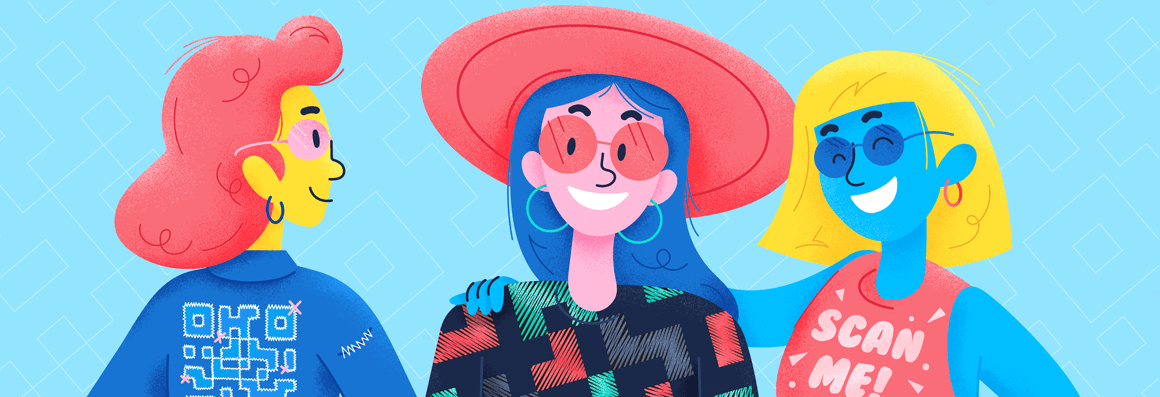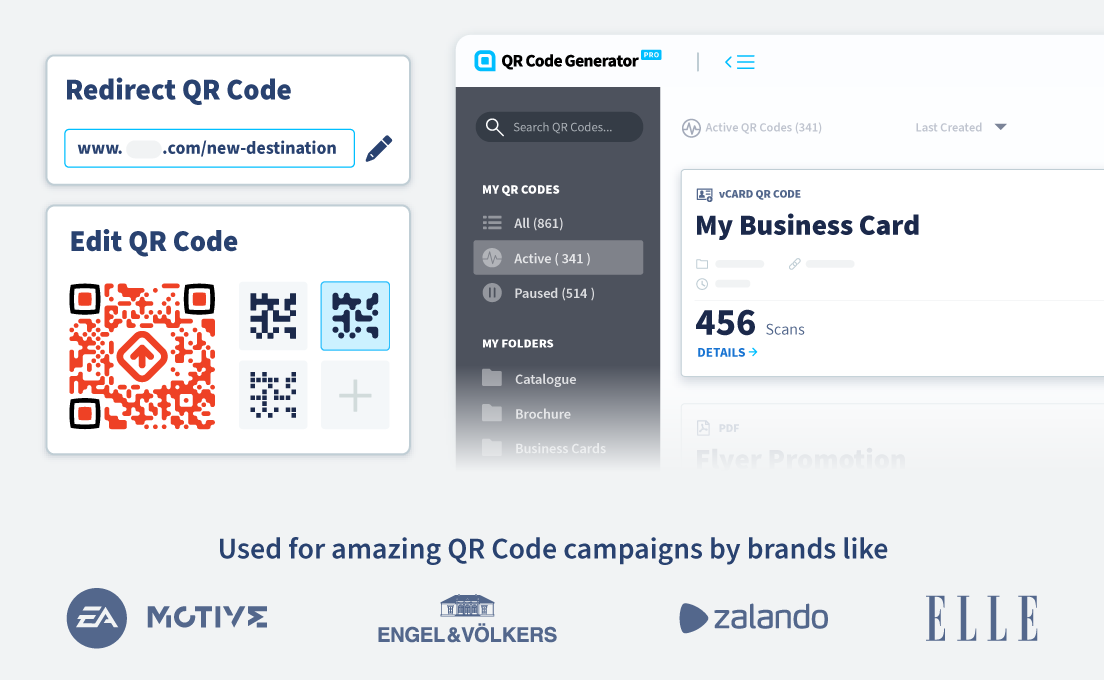- Best Practices ●
- COVID-19 ●
- Industry Trends ●
- Partners ●
- Product ●
All About QR Code Bracelets: What They Are, How To Use Them, and More
Did you ever imagine we’d wear QR Codes on our arms? QR Code bracelets are the latest way people are using QR Codes in both personal and professional contexts. While they may seem strange, their functionality allows us to share information, engage customers, and connect with others.
With the fluidity of QR Code design, the flexibility of Dynamic URL QR Codes, and the features of QR Code types, it’s easy to see why QR Codes are becoming a marketer’s best friend.
In the true fashion of the QR Code, the QR Code bracelet is so much more than an accessory. Let’s dive in!
What is a QR Code bracelet?
A QR Code bracelet is a bracelet with an embedded QR Code. They can be either disposable or reusable; thus, they are made from various materials ranging from paper to sturdy plastic to stainless steel.
These bracelets are used in various contexts, from medical alert bracelets to event wristbands.
Top benefits of creating a QR Code bracelet
The spreading popularity of QR Code bracelets reflects their wide variety of convenient uses across our personal lives and corporate needs.
Faster information sharing
QR Code bracelets can share information with a single scan. Not only that, but they can contain a lot of information—more than would be practical to carry with you or print on a business card. You can encode the bracelet with extra details for security or convenience.
Not only are QR Codes easy to use, but they can save time. The saved time can speed up ticket lines or help save lives in a medical emergency.
Enhanced brand identity
When using QR Code wristbands for events or marketing purposes, you can decorate them with brand logos and colors. When people wear them, it reinforces your brand identity for the wearer and for anyone who sees them wearing the bracelets.
You can also personalize QR Codes with different colors, logos, and text. Get your call to action in front of the customer while blending the QR Code into your branding.
More engagement
QR codes are easy to use and invite engagement with your brand. Instead of taking a risk that customers who see your marketing materials will look you up later, you can prompt them to scan and visit your website immediately.
How does a QR Code bracelet work?
QR Codes bracelets are intuitive for anyone who has worn a bracelet or scanned a QR Code. But there are some things you should consider when making your own QR Code bracelets to ensure they work as intended.
QR Code clarity and size
To make sure a customer can easily scan a QR Code, they should be printed with clarity and size in mind. QR Codes should be at least 2 cm wide, but ideally larger, with high-quality printing. That means your QR Code bracelet should be at least 2 cm wide, too—thin QR Code bracelets are not an option.
Scannability
There are a few best practices in QR Code design that help them scan correctly:
- The QR Code should be printed in high-contrast colors. This is why so many are black and white, but different colors are acceptable, too.
- The linked URL should be short enough to ensure the resulting QR Code is simple. More complex QR Codes have more tiny squares and are more challenging to scan. You can use a URL shortener service if you have a long URL.
- The QR Code should have a “quiet zone” around the code. This refers to the white space around the square that helps the QR Code scanner identify the code.
Following these practices will reduce customer frustration with scanning QR Codes and allow you to connect with your audience.
Link stability
The page you link to with your QR Code should be maintained so that the QR Code continues to work. If the page directs to a 404 error, you lose your opportunity to engage with your customer.
You should also ensure the link stays on topic. For example, if you create a QR Code to link to a sale page and then decide to use the URL as a product page instead, anyone who scans the QR Code will be confused.
Dynamic QR Codes are great at helping promote link stability. Because you can change the QR Code’s link, you can switch the link to a different relevant page if the original page is moved or closed.
Ways to use QR Code bracelets effectively
People love QR Code bracelets for their usefulness. Without a strong purpose, your audience will have no interest in wearing them. Before creating your bracelet, consider what results you want and how it ties back into your overall goals. Here are some common, excellent use cases that already exist in the real world.
Customer service
QR Codes allow you to connect customers to the digital resources they need. This is most useful during customer experiences, such as stays or events. Consider the following customer service use cases:
- Hotels offering guests wearable tech, such as a bracelet room key. A QR Code printed on the bracelet can connect guests to resources like room service, FAQs, or front desk help.
- Music festivals using bracelets to identify ticket holders. If the bracelet has a QR Code, attendees can instantly access festival schedules, water station maps, and help.
- Event ticket bracelets using QR Codes to link to customer surveys. This allows you to gather more feedback about the event and use it to improve the next one.
You can use QR Codes in almost any situation where you wish to offer immediate, digital self-service to customers. The QR Codes can encourage customers to help themselves before asking questions or taking up staff time.
Networking and corporate promotion
Business cards are (largely) a relic of the past. Not only do people rarely exchange them, but they go out of date quickly because people frequently change roles and companies.
vCard QR Codes have quickly become an alternative: vCards can quickly be exchanged with a single scan, which is great for networking events. For example, you can give each conference attendee a unique QR Code bracelet linked to their professional contact information, such as phone numbers and emails. This will encourage attendees to swap information and make your event more of a success.
You can also use QR Code bracelets for corporate promotion. Conference vendors love to give away merchandise—handing out cute bracelets with QR Codes can encourage table visitors to scan and check out your company later.
Health and safety
QR Codes can be a fantastic addition to medical ID and alert bracelets for children or those with medical conditions.
MedicAlert Foundation, for example, is a non-profit that utilizes QR Code technology to make MedicAlert members’ medical information and health records more readily accessible, especially to first responders during medical emergencies.
The QR Code medical bracelet stores patients’ health data: a detailed personal history of a person’s health conditions, allergies, vaccination status, and more. First responders must scan the QR Code bracelet to acquire members’ medical profiles with their smartphones.
KeepMeSafeID primarily focuses on bracelets for children with special needs as well as adults dealing with mental decline. The bracelet contains info about the person’s medical conditions, and once the QR Code is scanned, an alert goes to an emergency contact, and GPS is activated.
QR Code bracelets can help keep anyone safe who may be prone to medical emergencies or getting lost.
QR Code bracelets make it easier for health professionals to access detailed patient history. Photo by MedicAlert UK on Unsplash.
Event planning
Bracelets are already an established tradition for large events, such as music festivals, conferences, fan conventions, and more. They’re a convenient way to prevent ticket holders from losing proof of their ticket and prevent attendees from sharing tickets. They can also contain other information—like branding and sponsorships and whether the wearer can order drinks at the bar.
QR Codes bracelets can allow the bracelet to act as a ticket. Event officials can scan the bracelet to confirm the ticket holder’s identity. You can even reward fans by having a QR Code on your event bracelet that links to a coupon for a discount to your next event.
Bracelets with QR Codes can also be used for more casual events. For example, “buy the bride a drink” bracelets with QR Codes to the bride’s Venmo have become popular at bachelorette parties.
Marketing
A wearable, branded object is marketing gold—especially if it’s useful enough for people to put it on. QR Code bracelets are a great way to turn your patrons into advocates by giving them a visible marketing tool they like.
It also helps your brand spread by word of mouth, which is always more convincing than promoted ads. Plus, it’s affordable and scalable. It’s easy to produce many at a time depending on the size of your audience and budgetary constraints.
Events that already use bracelets can turn them into a marketing bonus by branding them with personalized QR Codes. If you don’t use QR Code bracelets, they can be a great addition to your marketing strategy.
How to create a high-quality QR Code bracelet
If the QR Code bracelet you create doesn’t work well, it will only foster frustration and distrust in your audience. Creating a high-quality bracelet involves following best practices, paying attention to the details, and testing along the way.
Design and test the QR Code
Use a high-end QR Code generator—like QR Code Generator PRO—to design your custom QR Code. Use one that allows you to personalize your code to incorporate brand colors, logos, and a call to action.
Then, you should choose where you want the QR Code to take the person scanning it. This could be your website, a special landing page, a social media profile, or a vCard with contact information. The possibilities are endless. But you should note that the code will be harder to scan the more data you use. You should use a link shortener if your URL is long.
Once you generate the code, you should go ahead and test the code with your own QR Code scanner. Maybe even zoom out to test scan smaller versions of it. You should even print samples and test those. If you can, test the code on multiple devices.
At the very least, test the QR Code scanners on iOS and Android—the two most common operating systems on mobile devices. Easy scannability is one of the most important factors for QR Code campaign success.
Choose your bracelet material
You can print QR Codes on almost any material. They can be engraved in metal or printed on paper. Plastic or silicone bracelets are a common choice. If events are outdoors or the attendees can expect to get wet, you can choose waterproof vinyl wristbands or even Tyvek—a durable, synthetic, paper-like material that’s waterproof and tearproof. Stainless steel is great for more permanent bracelets, like medical IDs. Though less common, you can even make a QR Code gold bangle.
Your QR Code bracelet material greatly depends upon the context. A sturdier material like metal or silicone would work well if you intend for the bracelet to be permanent, such as a medical alert bracelet.
If your bracelets are temporary, such as for a weekend music festival, paper or plastic bracelets might do the trick and provide some cost savings. If they’re temporary, you can even use QR Code stickers to put onto bracelets you already have.
Finalize the bracelet design
As you decide what your bracelet looks like, balance aesthetic appeal with QR Code readability. Since the QR Code is the point of these bracelets, ensuring they will be easy to scan is important.
You should also choose adjustable bracelet designs—or have multiple sizes available—to be inclusive to those with different wrist sizes.
Check for quality
It’s a good idea to get samples of a bracelet before you order hundreds or thousands of them. This way, you can test them for print quality and durability. Be sure to, again, test the QR Code with multiple devices.
Choose suitable packaging solutions
Now for the fun part—packaging! Packaging for your bracelet can also be an extension of your brand. For example, an eco-friendly company will want to choose eco-friendly packaging, such as biodegradable paper envelopes versus non-recyclable plastic alternatives.
Packaging should also reflect delivery. If, for example, you plan to mail them, ensure you have packaging that will efficiently cover shipping costs while protecting the bracelet.
Explore the future of connecting with others using QR Codes today
QR Code bracelets are a great way to delight your audience with a useful, interactive object that connects with people physically and digitally. With various use cases, whatever your goal is, you can innovate how you get there with QR Codes.
QR Code Generator PRO has high-end features to create QR Code bracelets that bring people together with your brand.
Ready to get started? Sign up for QR Code Generator PRO today to elevate your next event or marketing initiative with QR Code bracelets.






 Add custom colors, logos and frames.
Add custom colors, logos and frames.
